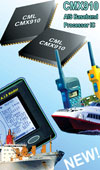Baseband processor for marine automatic identification
15 June 2005
DSP, Micros & Memory

The CMX910 is a highly integrated baseband signalling processor IC from CML, for class A and class B marine automatic identification system (AIS) applications.
Half duplex in operation, it comprises two parallel I and Q Rx paths, and one Tx path, all configurable for AIS or FSK (DSC) operation. The device performs channel filtering and signal modulation/demodulation, along with associated AIS functions such as training sequence detection, NRZI conversion and HDLC processing (flags, bit stuffing/de-stuffing, CRC generation/checking and slot-timing).
The 1200 bps FSK demodulator interface provides the third parallel decode path, using an external FSK modem, required by the AIS class A market. Integrated Rx/Tx data buffers and a slot/sample timer are also provided - reducing the processing requirements of the host microcontroller. The thoughtful provision of a C-BUS controlled interface expansion port, device enabled ports and versatile auxiliary ADCs and DACs, further simplify system hardware design, reducing the overall end-equipment cost and size.
The CMX910 is also capable of transmitting on either AIS channel (GMSK-9600 bps) or FSK (1200 bps) on the DSC channel, as required. As an ultra-low-power IC, many of the CMX910s on-chip functions can be powersaved when not actively required.
Further reading:
Memory for asset tracking
Altron Arrow
DSP, Micros & Memory
The Page EEPROM, ST’s latest memory, has been designed for efficient datalogging and fast firmware upload/download in battery-operated devices.
Read more...
Engineered for high-reliability applications
Future Electronics
DSP, Micros & Memory
The MCX E series of Arm Cortex-M4F and Arm Cortex-M7 microcontrollers from NXP are engineered for demanding industrial and IoT environments.
Read more...
NXP’s development platform guide
DSP, Micros & Memory
Choosing between the FRDM i.MX 93, FRDM i.MX 91 and FRDM i.MX 91S development platforms can be intimidating, but once designers understand how each platform aligns with their application’s requirements, the decision becomes straightforward.
Read more...
XJTAG launches two new Flash programmers
ASIC Design Services
DSP, Micros & Memory
XJTAG has announced XJExpress and XJExpress-FPGA, a pair of Flash programmers perfect for development, debug and in-service applications.
Read more...
Processor offers competitive solution for advanced HMIs
Future Electronics
DSP, Micros & Memory
The new RZ/A3M microprocessor from Renesas features 128 Mbytes of fast DDR3L DRAM memory for system cost reduction, and supports
1280 x 800 px video resolution at a rate of 30 frames/s.
Read more...
ESP32-C6 achieves PSA-L2
iCorp Technologies
DSP, Micros & Memory
Espressif Systems recently announced that its ESP32-C6 microcontroller has achieved PSA Certified Level 2 (PSA-L2) security certification, making it the first RISC-V-based MCU to reach this level.
Read more...
Microprocessor with integrated NPU
Avnet Silica
DSP, Micros & Memory
The RZ/G3E from Renesas is a microprocessor integrated with quad CPU and NPU in one chip, improving power efficiency, reliability, and security.
Read more...
Nordic Semiconductor launches nRF Connect SDK Bare Metal option for nRF54L series
Avnet Silica
DSP, Micros & Memory
This is a new, RTOS-independent software solution for Bluetooth LE development, designed to ease developers’ migration from the legacy nRF5 SDK and nRF52 series to the next-generation nRF54L series.
Read more...
Dual-core support in NECTO Studio
DSP, Micros & Memory
MIKROE recently announced that version 7.3.0 of its NECTO Studio Integrated Development Environment now supports dual-core MCUs, allowing designers to program and debug each core independently.
Read more...
Post Quantum Cryptographic firmware library
DSP, Micros & Memory
The STM32 post-quantum cryptographic library enables developers to satisfy application requirements for any combination of data integrity, confidentiality, identification/authentication, and nonrepudiation.
Read more...


